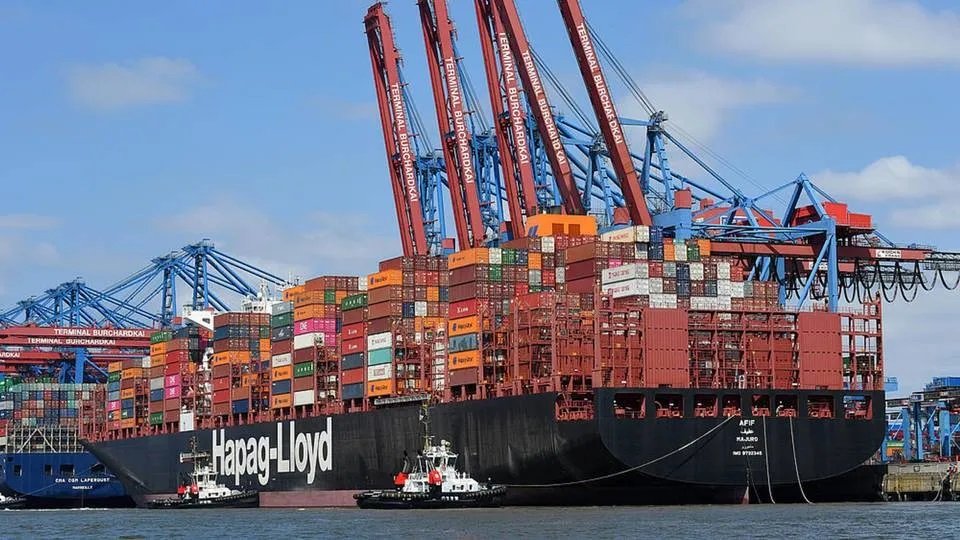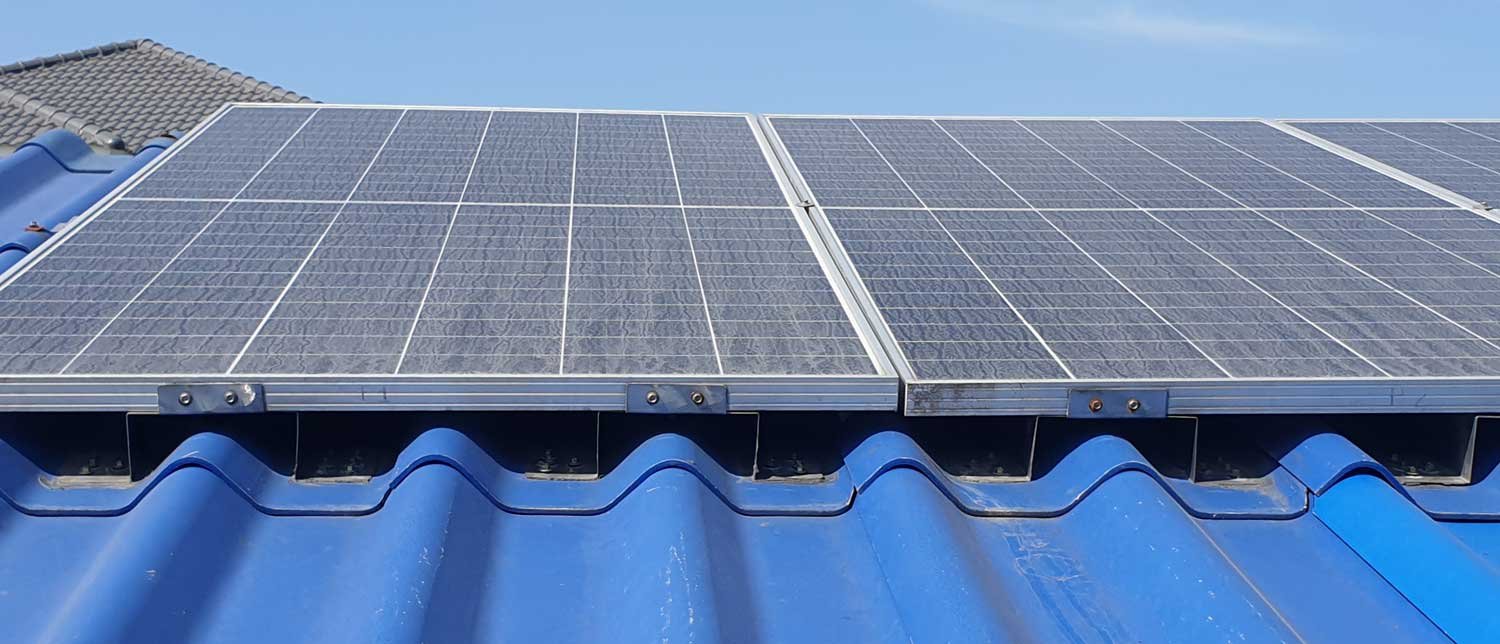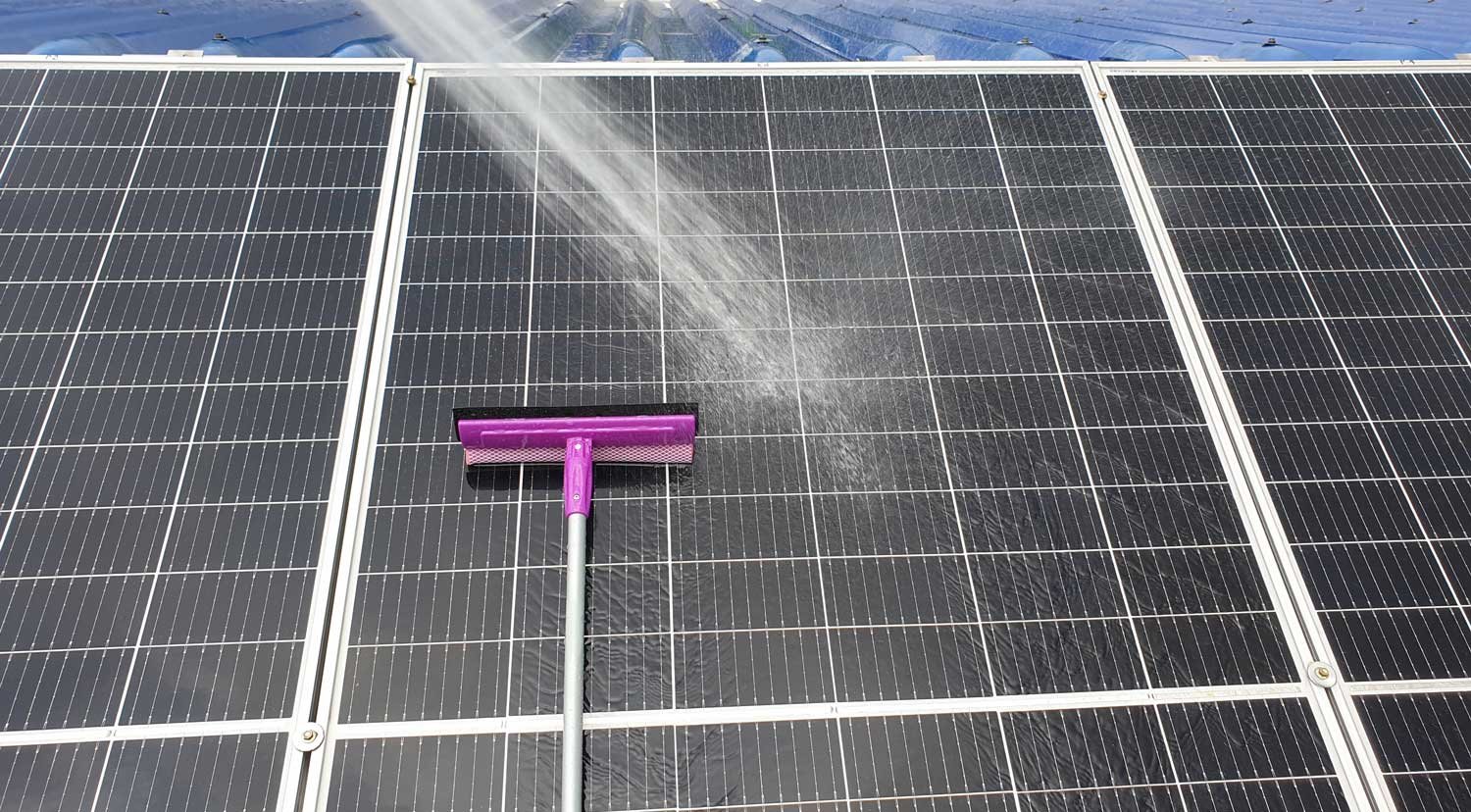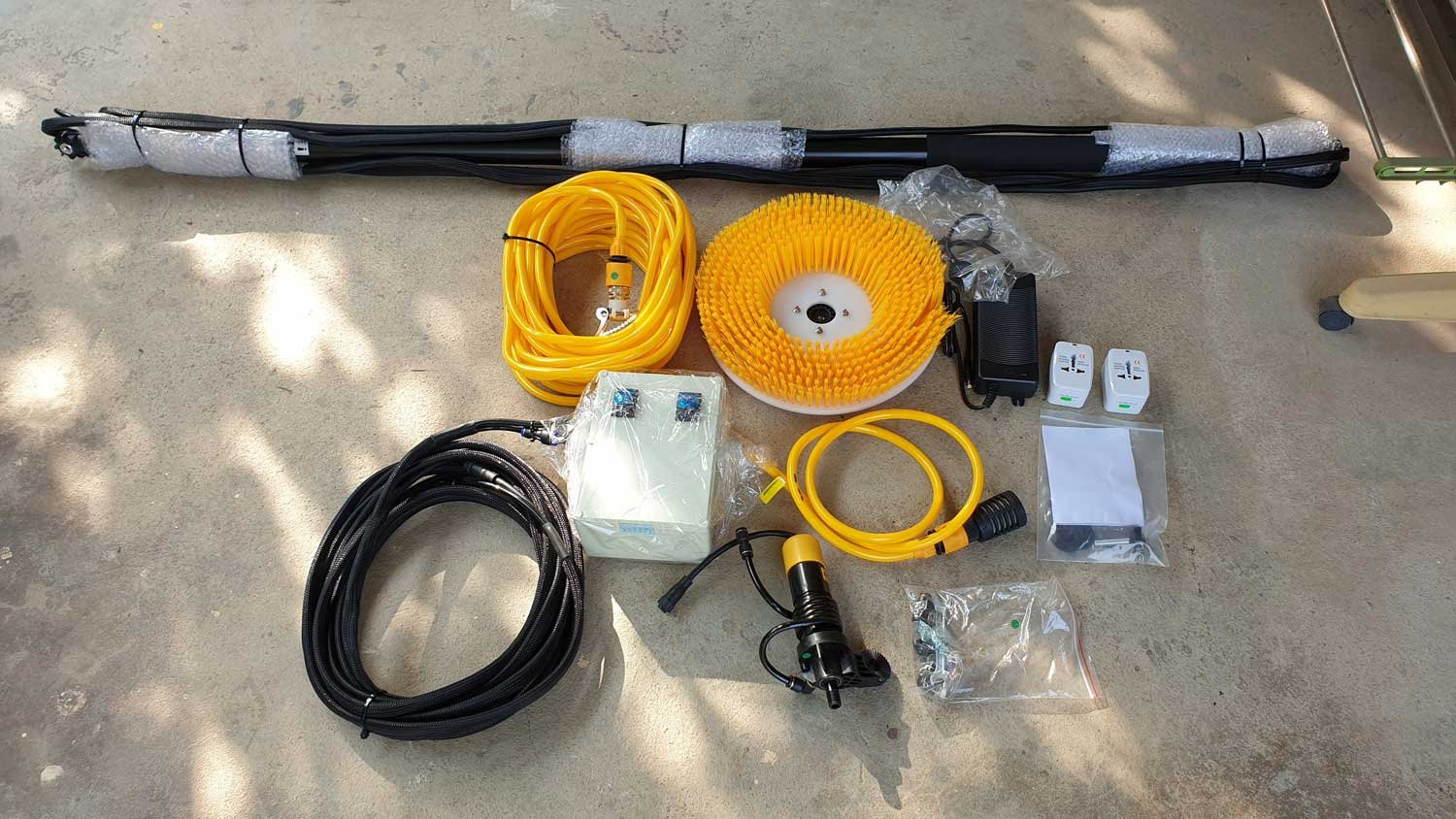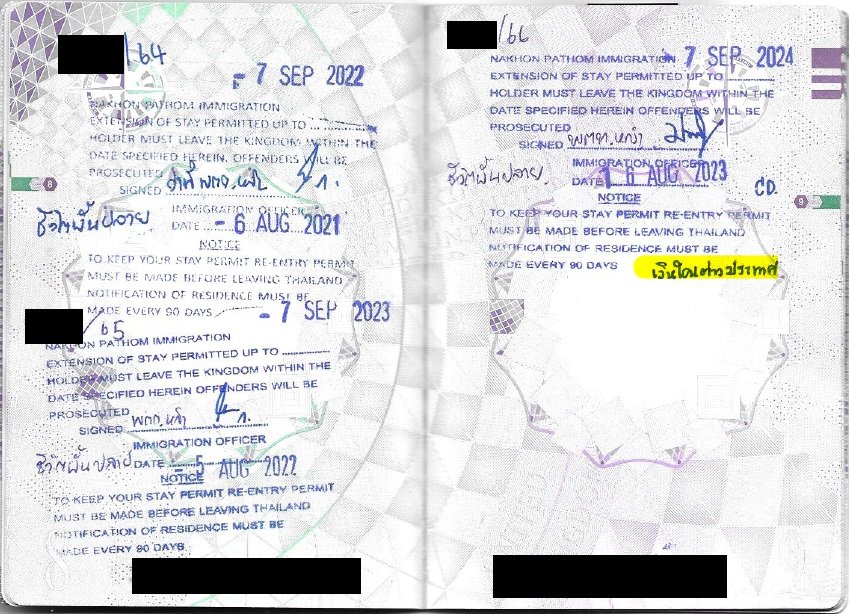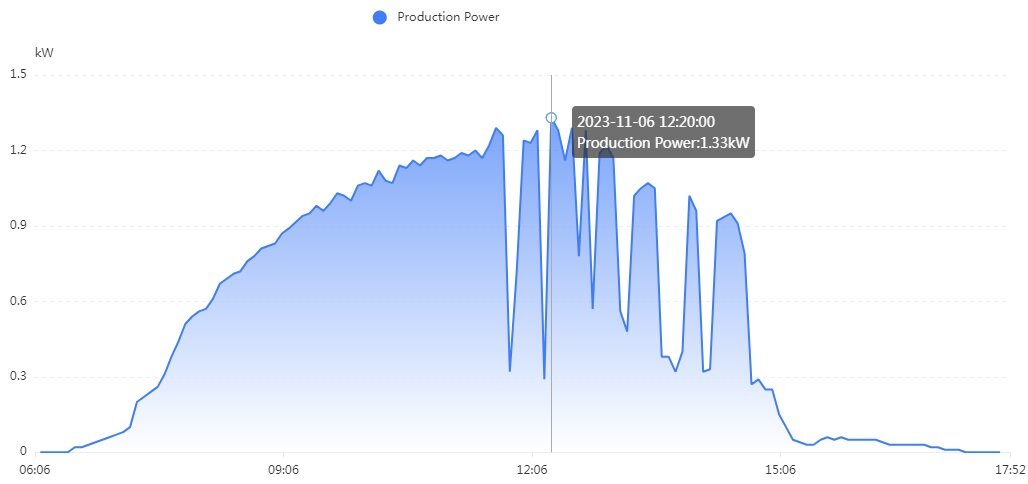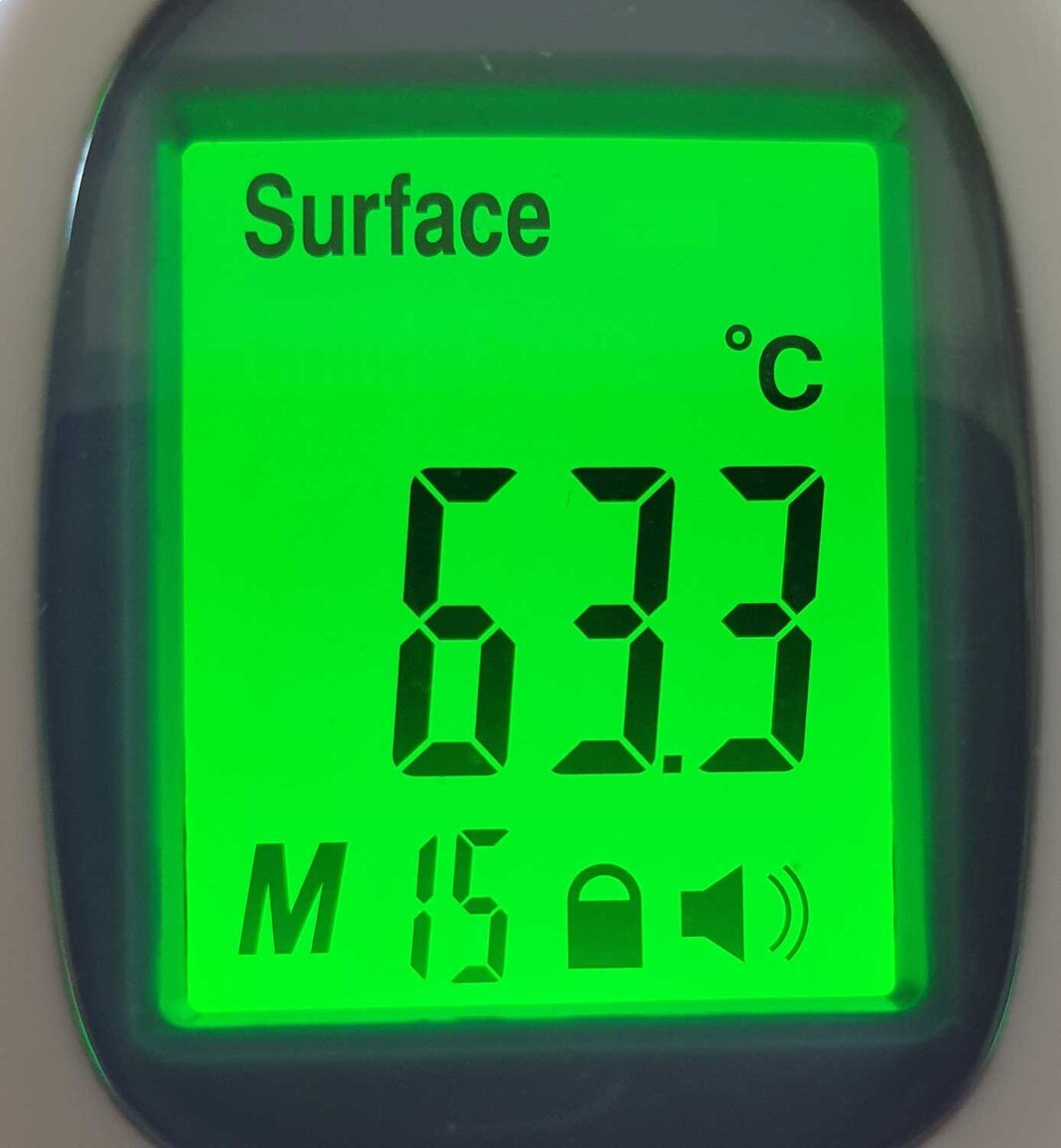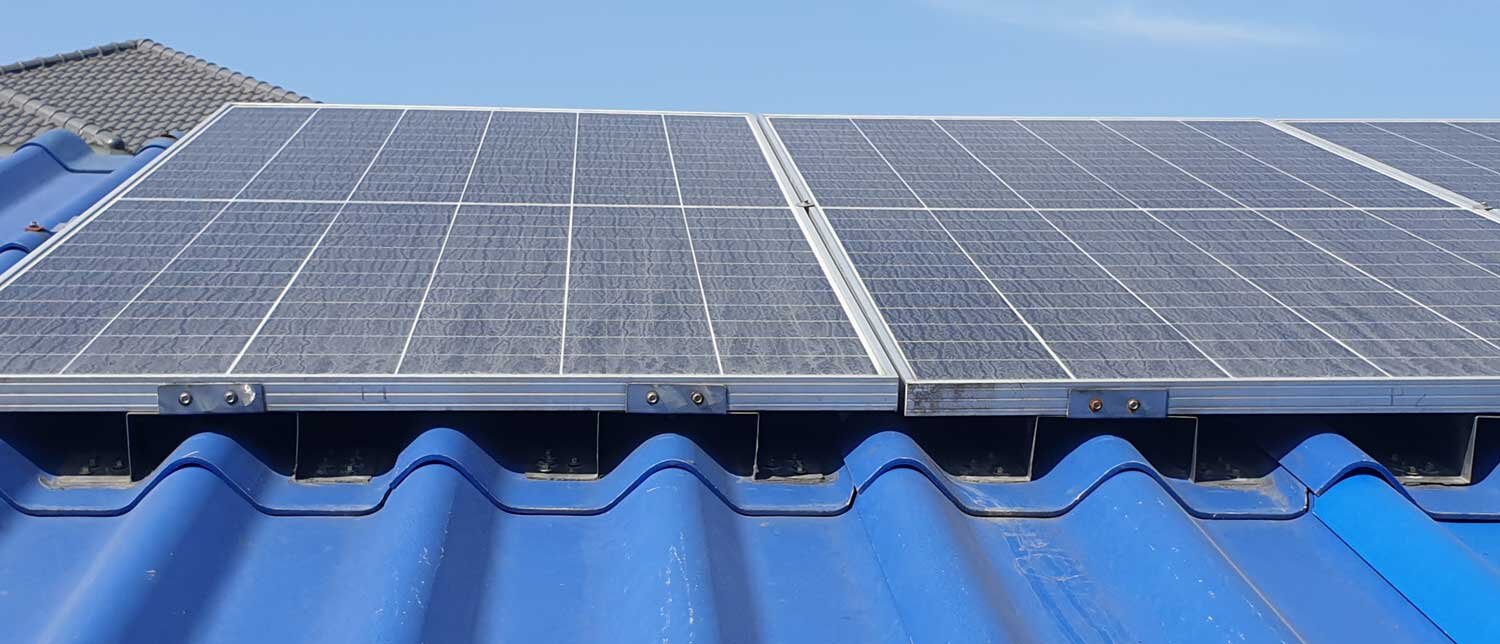-
Posts
933 -
Joined
-
Last visited
Content Type
Events
Forums
Downloads
Quizzes
Gallery
Blogs
Everything posted by 007 RED
-

PEA found out meter is spinning backward
007 RED replied to eddysacc's topic in Alternative/Renewable Energy Forum
Back to the original post = PEA found out meter running backwards. Back in October I posted (ROI After 2 Years) that my small scall GTI system had been operational for 2 years, and that during that time it had produced nearly 6,000 units, which had knocked almost 25,000 THB off our electricity bills. At the end of my post, I indicated that I would not do anything more with the system unless our local PEA decided to swap the lovely spinning disc meter for a new shinny digital one. Well, that end thought almost came true recently. About 6 weeks ago, my wife was at a hospital in BKK for a routine medical check up and was just about to be called in to see the doctor when she received a phone call. The caller stated that he was from the PEA and that he was coming to the house the following day to fit a digital meter. He asked if she would be home around 10am. He then asked if she had claimed a refund on the original meter installation. My wife advised the caller that she would be at home but that she couldn't remember if she had claimed the refund. Because she was being called into see the doctor, she had to end the call. After seeing the doctor, she called me to advise me about the phone call. You can image what was went through my mind, namely, how the heck did the PEA find out that we had solar? The system can’t be seen from the roadway outside the house/car port. Did they see the meter spinning backwards whilst we were not at home? Had someone ‘grassed’ on us? When my wife got home, she spoke to several of the neighbours whose meters share the pole outside our house, and none had received a call from the PEA. So, were we the only one to have our meter changed? So, with the possibility of the PEA turning up next day to replace our spinning disc meter, I decided to play safe and turn the solar system completely off. The following day we waited patiently for the PEA to arrive. 10am came and went. 12 noon passed. 5pm elapsed and still no sign of anyone from the PEA. So, my wife called the mobile number that had rung her the previous day to try and find out what was happening. Despite several attempts to call the number there was no reply. As we were usure as to when the PEA might turn up, I decided to leave the system turned off until they had been. A week passed and still no sign of the PEA. After another week I turned the system back on in ON EXPORT mode, so that at least we would get some power produced by the system, but the meter should not spin backwards. After a further week, and still no sign of the PEA, or further phone calls, I turned the system back on into EXPORT mode. To date, other than the normal meter reader, there has been no sign of any PEA, thankfully. Perhaps I should not speak to soon. In hindsight, I now believe that this may have been some sort of scam call that did not play out because: a) my wife needed to end because she had been called to see the doctor; b) my wife is certain that the caller did not mention the house number during their brief conversation; c) why did the caller not answer the phone (it was a mobile number); and d) if he was from the PEA as he said, he should have been able to look up on their computer system if my wife had claimed/received a refund for the original meter. Because of this event, I’ve decided to upgrade my small system, as @Crossy suggested in my ROI post, by initially adding a few extra panels and possibly running the system in NO EXPORT mode to just cover day time needs. Thinking longer term, a hybrid inverter with more panels is a possibility, but without being attached to any ESS. Given my age (77), with the probability that I will fall off my perch at some time, my darling wife has indicated that she does not feel confident enough to look after a battery system. Moral of the story.... Spinning the disc backwards has its rewards, but also its downside. -
Sorry but this is almost doomed to failure before it gets anywhere near the ‘drawing board’, it’s just a big dream that’s going nowhere. According to earlier reports the ‘Joly Green Giant,’ indicated that the overland bridge proposal will knock of 14 days sailing time around the Straits of Malacca and thus save both time and money for the shipping companies. I seriously question his previously reported 14 days sailing time around the Straits of Malacca. Sure, the Straits of Malacca is a busy shipping lane, but it only takes a couple of days to sail from say Chumpon to Singapore, and a further 2 days to get up to Phuket. A total of 4 days, and perhaps allowing another day for ‘traffic jams’ or slow movement through the Straits. The average SMALL container ship has a capacity of around 500 (40ft) containers. So, when the vessel docks at Chumpon the ‘Joly Green Giant’ is proposing that these 500 containers will be off loaded onto either trucks, or trains, and transported overland to Ranong, where they will have to be reloaded onto another vessel which will be waiting at that port for those containers. With one 40ft container per truck, that would mean having 500 trucks on standby at Chumpon. Oh, and then there is the little matter that some containers may well require refrigeration. Will there be enough trucks capable of providing such facilities? Can you imagine a convoy of 500 trucks ‘racing’ down the highway from Chumpon to Ranong. The return trip will likely feature on the next instalment of ‘Fast and Furious’. What could possibly go wrong? The alternative would be to transport the containers by train. Given that modern freight train can haul about of 50 (40ft) containers, that would mean having 10 trains on standby at Chumpon for this one vessel. Then you need more trains on standby for the next vessel etc. A possible safer and more environmental solution. It must also be remembered that the order in which the containers were originally loaded onto the vessel has been determined by their eventual destination. So, when the first container is off loaded at Chumpon, it is imperative that it must subsequently be the last container to be reloaded at Ranong. This will require good planning (again, what could possibly go wrong?) and necessitate sufficient storage area at Chumpon or Ranong to put the containers prior to being loaded onto truck/trains/vessel. Now consider the LARGE, or SUPER, container ships which can have a capacity of 20,000 plus (40ft) containers like the one on the photo above. These would be a complete nightmare. How much will the off-loading, overland transportation and subsequent re-loading cost the shipping company, plus the cost of having to have 2 vessels tied up? Will the off-loading, overland transportation and subsequent re-loading be quicker than the possible 5 days sailing around the Straits of Malacca? I personally doubt very much that investors, or shipping companies, will want to buy into this 'hair brain' scheme as the numbers just won’t add up for them. Now if the ‘Joly Green Giant’ was to suggest constructing a real canal, like the Suez or Panama canals, then that would be more likely to attract investors and shipping companies. Also, the cost of such a project would be considerably higher than the ‘land bridge’ proposal, thus there would be far more opportunities for ‘commissions’ to be had .
- 44 replies
-
- 10
-

-

-

-

-

Growatt SPF5000ES Offgrid 9kw DIY Solar Project
007 RED replied to Pink7's topic in Alternative/Renewable Energy Forum
Congratulations on your DIY solar project. It looks a really good job and hopefully it will pay its way in a relatively short time frame. Regarding cleaning your panels: Its not really a good idea to use soap to clean them, for a couple of reasons: - Firstly, you never know what chemicals the manufacturer has put into the soap to give it that ‘extra’ cleaning boost. There is a danger that these chemicals may cause the seal between the glass and the frame to break down over time and allow water to get onto the photovoltaic cells, which will cause the panel to fail. Definitely do not use standard window cleaning solutions to clean your panels as these contain alcohol-based substances which will cause the panels seal to degrade fairly quickly. Secondly, even if you flush the panels off with water after soaping them, the soap will still leave a very fine film on the glass which tends to attract dust, so you will be back in the same situation of having to clean the panels again soon. The best solution for cleaning solar panels is rainwater, as opposed to tap water. Tap water inevitably contains calcium and when the panels dry off, the calcium sticks to the panel’s glass. Initially this will have little, or no, effect on your array’s output, however, each time you clean the panels this calcium film gradually builds up and will eventually reduce the amount of sun light that strikes the photovoltaic cells of your panels, hence, reduced output. The small-scale system on my carport roof (4 x 415W panels) tends to get dirty fairly quickly due to the fact that we live in an area where there are a several food producing factories nearby which are far from pollution free. See photo below of my panels after about a month during the ‘dry season’. The best solution for cleaning the panels is rainwater. During the ‘rainy season’ my panels get a good regular clean without any input from me, which is great, and there is always a noticeable slight increase in the array's output following a good shower. I collect rainwater in a 1k Liter tank (very basic filtering to eliminate any large particles) which I use specifically for cleaning the panels. Initially I used a hose and soft brush to clean the panels. This was followed by a squeegee to remove any surplus water, and then a cloth to dry them off. This was hard work, especially at my age. So, I decided to invest in a commercial solar panel cleaning brush. It was a bit expensive, and some would consider it ‘over the top’, but it has made cleaning the panels a lot easier. The brush cleaner comes with its own small pump, which is connected to the rainwater tank. Once the panels have been washed, I now use a small battery powered garden blower to remove any surplus water. It now only takes about 10 minutes to set up and clean my 4 panels. I’ve attached below some photos of the brush kit and a short video of me using it. 20230226_095040.mp4 FYI…. I’ve attached a PDF of the brush spec. Solar Panel Cleaning Brush Cleaning Equipment Solar Panel Cleaning Rotating Brush For Customized - Buy Solar Panel Cleaning Rotating Brush For Customized,Solar Panel Cleaning Brush,Solar Panel Cleaning Equipment Product on Alibaba.com.pdf Hope this helps and gives you some ideas. -
Up-Date: Many thanks to those AN members who have provided constructive comments. Much appreciated. Well, the jury is divided. 50% of AN members who responded indicated that I need to maintain 65K monthly international transfers until I go for my renewal in September next year, the other half say that there’s no need for the monthly transfers and I just have to show that 800K has been in the bank 2 months before going for my renewal. So, as I have mentioned in a couple of my previous posts, I decided to visit my local Immigration Office, which I did this afternoon (well not so local, it’s a 60km drive each way through heavy traffic) and have a chat with the senior there who has been very helpful in the past. Having explained my desire to transfer from the monthly international transfer method to money in the bank method at my next renewal in September 24, she confirmed the following: - 1. I must continue to transfer 65K from an international source to a Thai bank up until the date of submitting my renewal and provide the same proof of these transfers as I have in previous years e.g. 1 year bank statement showing international transfer of funds to Thailand; copy of my foreign account bank book; certified letter from bank confirming that I am the holder of the account and the amount of funds at that date. 2. I must also provide my bank book showing 800K in the account 2 months prior to submitting my renewal, plus a certified letter from the bank confirming that I am the holder of the account and the amount of funds at that date. Then came the shock! She indicated that as this was to be my first submission for the 800K method, I need to:- 1. Show proof of the origin of the funds in that account. 2. I also need to provide a letter from my Embassy confirming my pension and that the Embassy letter must by authenticated by the Ministry of Foreign Affairs. I explained to her that the funds in my savings account, which amount to several million THB have accumulated over the past 13 years by ‘drip feed’ transfers from my Foreign Currency Account. There is no way that I will be able to obtain any form of bank statements that will show these transfers dating back more that perhaps the past 12 months. Because recently these transfers were made via my mobile app, I have some copies of transfer receipts on my phone, which I showed her. Following my comment, she advised that the past 12 months would be acceptable and that I need to print them out and submit them when doing my renewal next year. I pointed out that my Embassy, like several other Embassies, stopped issuing letters confirming pensions several years ago, so there is no way that I can comply with that requirement. She advised that I need to obtain a letter from my pension provider(s) confirming the amount of my pension and that these must be submitted with my renewal application to confirm that I have sufficient funds to live on (God only knows why they need this). I decided to not ask to her questions as to the reason why I must prove where the funds of my 800K in my savings account have come from, or the reason for why I need a letter from my Embassy confirming my pension(s). I felt that such questions would lead to her ‘digging her heels in’ with a negative outcome. I left thanking her for her advice. So, in conclusion, I will have to continue transferring 65K (plus) per month from the UK bank account to my Thai Foreign Currency Account up until September next year and ensure that some THB funds are transferred each month to my savings account. Hopefully my P60s from my pension providers will satisfy her second requirement. All good fun?
-
Many thanks for your response. I have a feeling that you are right in so far that I need to keep making the transfer of funds until my next renewal in September 2024, but as you suggest, I'm going to take a drive to my 'local' Immigration Office and have a chat with the Senior there to get her view on the matter. She's been very helpful in the past. The only problem is that if she says that its OK to reduce the amount of funds that I transfer monthly, and rely upon the money in the bank method for my next renewal, you can bet your bottom dollar that she gets transferred and the new boss has the opposite view. Then I'm up the creek without a paddle. Once again, Thanks.
-
Many thanks. That is what I am expecting. May I ask, is your comment based upon personal experience? I am considering a trip to my local Immigration Office (not that local actually - 1 hour plus drive each way) and having a chat with the Senior there who has been very helpful in the past. The trouble is, when it comes to my renewal next September, she may have been transferred and the new incumbent may well have a different view.
-
I, like many other expats here in Thailand are hoping that this is a 'storm in a teacup', and that it does not become a reality. Although Thailand has Tax Treaties with 60 plus countries which are intended to avoid the possibility of double taxation, knowing the Thai Government, they may well try to enforce the clause which requires that transfers come from savings accounts, where the funds have been for 12 months prior to being transferred. I'm not holding my breath, but just trying to think ahead for the worse case scenario.
-
The 'story' as you put it is not complicated at all. As I mentioned in my original post, I been renewing my Non-O (Retirement) permission to stay for the past 13 years based upon transferring the equivalent of 65,000 THB (plus) per month to a Thai bank account from an overseas source. I also have savings account which hold substantially more than 800,000 THB for the past several years. To put it as simply as possible, I want to change from the monthly money transfer method to money in the bank method. What I'm asking is, is it OK to reduce the amount that I transfer so as to cover basic living expenses and when I go for my next renewal in September 2024 can I just present my updated savings account book (plus certified letter from the bank), or will Immigration expect to see me continuing money transfers up until my new submission. The problem is that with the money transfer method, the permission to stay is based upon retrospective transfers which have been made in the past year, not what you might transfer in the forthcoming year. For your information: With Non-O (Retirement) Permission to Stay there is no requirement to have compulsory health insurance thank goodness because at my age 77 such insurance is virtually unobtainable or so prohibitively expensive with so many exclusions. Hence the reason why I have a very healthy savings account for that 'rainy day'.
-
Thanks for your response. Like you, I currently transfer more than the minimum 65K per month. However, we (my wife and I) are careful spenders and we never need all of the funds which I've transferred into my foreign currency account. This has allowed me over the years build up a very healthy savings account which is there for that 'rainy day'. I like your thinking regarding transferring 50% of your transferable funds to your wife. Yes, if the Revenue Department do enforce the tax rule of foreign transfers, your potential tax liability will be reduced. But, your wife may now have to pay tax if she is not already on the amount that you transfer to her. Obviously, if she is already paying tax (like my wife does), then her tax liability may well increase substantially. It will be a case of 'swings and roundabouts'.
-
Sorry, but I would be interested to know on what factual basis do you suspect that the rules for Non-O Extension of permission to stay will change soon? There have been rumours for the past year that Immigration are re-writing the Immigration Act, but so far nothing has materialised from either Immigration HQ, or the Ministry of Interior, or the Ministry of Foreign Affairs. As I asked in my original post, what are the procedures for changing from the monthly international transfers into a Thai bank account method to the 800K in a Thai bank savings account. The problem in simple terms is, do I need to maintain the monthly transfers until my next renewal (September 24), or is it OK for me to lower that amount to just cover basic life expenses and hope that my local Immigration Office will accept that the 800K (plus) in my Thai savings account has been there for several years, and grant me permission to stay for another year (Sept 24 to Sep25). I'm not sure that using a foreign credit card to pay for all and sundry, as you suggest, is going to be financially worthwhile bearing in mind that most credit card exchange rates are poor, plus may banks impose a surcharge. In addition, many Thai shops and service providers impose a 3% surcharge for use of credit cards. In a year, it may be better off paying the tax if it is enforced.
-
Again, many thanks. Its a few years old and there are some conflicting suggestions/recommendations e.g. yes maintain international transfers until next renewal, and no need to maintain the transfers if the 800K is in the bank at the time of the current renewal. I am mindful that each Immigration Office/Officer sets their own criteria, and that this can change from day to day, depending what side of the bed they got out that morning. That said, I may well take a trip to my Immigration Office (about an hours drive away) and have a chat with the senior there to try and get her ruling on the matter. As I mentioned in my original post, I was hoping that if I don't need to maintain the 65K monthly international transfers to satisfy Immigrations requirements, and only transfer funds necessary to day-today living, this might help reduce any tax burden should the Revenue Department implement taxing incoming international funds.
-
Thanks for your advice/observations. I've been thinking about taking a trip to the Immigration Office and posing the question in the hope of getting the line from the 'horse's mouth'. The only trouble is that what the senior IO indicates now may well be different come September next year. Interesting point that you made that the Immigration Officer may not have any indication what method I used for my previous P2S. I just looked at my passport (Photo below) and noticed that for the first time for the previous years, there is a notation (which I have highlighted) indicating in Thai that money abroad (according to Google Translate).
-
As you have suggested, I'm still maintaining the monthly international transfers, but it would be nice to know if that is really necessary. I appreciate that Immigration most likely wont agree with my logic, but my thinking is:- With the 65K international transfer method, they (Immigration) are looking to see that you have made the correct international transfers for each of the previous 12 months. Not what you might transfer in the forthcoming 12 months. Provided you have the necessary documented evidence in your bank statement of your past transfers, they (Immigration) will renew your Permission to Stay for the forthcoming 12 months. So, if I have 800K (plus) deposited in a savings account prior to the date that the latest Permission to Stay was granted, should that not be acceptable for the next renewal? Hence the reason for my post, to see what any other AN members have experienced when changing from monthly international transfers to 800K in the bank.
-
I’m sure that this has been raised before, but unfortunately my searches via Google and AN have only revealed the procedure the other way around e.g. changing from 800K in bank to 65K monthly international funds transfer. Background: For the past 13 years I’ve been on annual renewal of Permission to Stay based upon my original Non-O (Retirement) visa. I have been using the 65K per month international transfer into a Thai Bank method since the British Embassy stopped issuing its letter to Immigration. Next renewal is due in September 2024. Considering the possibility of the Revenue Department taxing my incoming internationally transferred funds next year, I’ve decided to change my annual renewal method to 800K in the bank and thereby lessen the amount that I need to transfer into Thailand each month to hopefully reduce my tax burden. I already have 800K (plus) in a savings account which has been there for several years, so there should be no problem with ‘seasoning’. My question is: Do I need to continue making 65K monthly international transfers into my Thai bank account until my next renewal is due, or can I reduce this amount now and just rely upon 800K (plus) when I do my next renewal? I appreciate that each Immigration Office (and possibly individual officers) will have its own interpretation of how such a change can be achieved, but I would welcome any guidance/experience from AN members who have recently gone through this transition.
-

DIY solar system - how to sell electricity to PEA
007 RED replied to 4myr's topic in Alternative/Renewable Energy Forum
@4myr May I firstly wish you the very best of luck with your endeavours to get approval to become a Small Power Producer (SPP) and to get paid by your local PEA for feeding back your surplus power to them. From what other members of the forum who have tried to get approval have enlightened us, it is no mean task. OK, my reason for posting the comments below is because of your aspiration that feeding back 10 units/day, at a payback rate of 2.2 THB, will give you a return of 70,000 THB over 10 years. I’m sorry to say it, but if you do get approval to become a SPP, I don’t think that you are going to get anywhere near the return of 70,000 THB within the 10 years that you are hoping for. I think that you will be extremely lucky if you get about half that amount assuming that the feedback rate (2.2 THB/unit) remains the same. Why only half your anticipated figure? At present with a normal meter the monthly 'Service Charge' (sometimes referred to as a Standing or Connection charge) which is shown on your monthly bill can be 8.19 THB/month, or 24.62 THB/month, depending upon how many units you purchase a month from the PEA. What you may not be aware of is that the moment you get SPP approval, and your local PEA installs your wonderful new feedback meter, they (the PEA) will up your monthly ‘Service Charge’ considerably . I recall that another member, quite some time ago, who went down the same route as you was horrified when he discovered the new ‘Service Charge’ for feeding his surplus back to his local PEA. Unfortunately, I can’t remember the figure that he quoted, and I can’t find any reference to this particular charge on any of the PEA websites. But as an example: If the ‘Service Charge’ for a feedback meter is the same as the charge for Time Of Use (TOU) meter, which is currently 312 THB/month, then at the current rate of 2.2 THB/unit feedback, you will need to feedback approximately 141 units each month, just to pay for the new ‘Service Charge’. Hence, based upon your anticipated feedback of 10 units/day for a 30 day month, this will give a feedback of 300 units/month. If you need to produce at least 141 units/month to cover the cost of the ‘Service Charge’, you will in fact only be getting 159 units, which at 2.2 THB will only give you a payback of 350 THB/month from your local PEA, which is unfortunately half of what you are expecting. I would seriously recommend that you double check with your PEA how much the ‘Service Charge’ will be if you get SPP approval. I hope for your sake that I'm wrong. I appreciate from your comments above that you have already submitted forms for approval to your local PEA, but please be mindful that giving to much information to your them will tip them off that you may well be running an unapproved DIY solar system, and this could lead to them making an unannounced visit to monitor your meter (spinning backwards). So be cautious. As I said at the beginning, best of luck with your project. -

Overstayer Busted at Airport
007 RED replied to dddave's topic in Thai Visas, Residency, and Work Permits
Looking back at this thread, I see that a couple of members have suggested that the airline check-in staff may well have ‘tipped off’ immigration. Personally, I very much doubt it as the check-in staff neither have the time to sift through the passport looking at each visa stamp, or the training to be able to identify if the passenger is on overstay. That said, when checking in an international passenger the airline’s computer system will advise the check-in staff if a visa is required by the passenger for their destination country and the check-in staff must check that the passenger has the necessary visa. Failure to ensure that the passenger has the necessary visa will result in the passenger being refused entry by the destination country and the airline being fined and having to bear the cost of returning the passenger to their original point of departure. So how did immigration know that the individual was on overstay? When the international passenger checked-in, his/her biographical details (Name; DoB; Passport No; etc) will have been entered into the airlines computer system. The airlines computer system automatically feeds the passenger’s biographical data into the Advance Passenger Information System (APIS). The APIS sends the international passenger’s biographical data to the destination country where various agencies such as police and immigration will determine if the passenger should be allowed to travel to their country. The APIS will subsequently send the airline a code indicating that the passenger can board the flight or a code which tells the airline not to board the passenger. The system does not give the airline a reason for a do not board instruction. As well as sending the international passenger’s biographical data to the destination country, the APIS also send the passengers biographical data to the departing country’s police/immigration etc so that they can check if the person is wanted for any reason. I suspect that some bright ‘student’ has recently written a simple query programme that allows immigration to check the visa type and issue date and determine if that the passenger is on overstay. It is possible that some form of alert is sent to the airport immigration office. A quick look at the CCTV of the airline's check-in counters and route to the departure entrance will easily identify the individual who will be stopped prior to getting to immigration departure desk. At present the reports indicate that this has only happened at Phuket, I suspect, however, that if this is successful as it has been in a couple of reported instances immigration may well introduce this facility at other international departure airports. Watch this space. So overstayers may well face being picked up at the airport prior to getting anywhere near to immigration and paying their fine in the future. -
Your assumption that in the real world there will be some loss is correct. In fact, the losses can be as high as 25%. So this is something that you need to bear in mind when doing your calculation with respect to the number of panels that you need. My system is small compared to what you are considering, but it can illustrate real world loss. My system comprises 4 x 415W monocrystalline half cut panels mounted on my carport roof, which is inclined at approximately 15o and facing due South, which in theory is an ideal installation that should be capable of producing 1.66kW. Below is a graph taken from my solar system monitoring facility yesterday. As you will see at 12:20pm the system was producing a max of 1.33kW. At that point in time, it was reasonably sunny, so the sunlight should hitting the panels almost perpendicular. That said 1.33kW which is approximately 20% below what the panels in theory should be capable of producing. FYI… The sudden drop in output was cause by horrible grey fluffy stuff floating by. The big drop in output around 3pm was caused by heavy rain/thunderstorm which continued to around 6pm. So what causes this loss? All solar panels are rated under laboratory conditions. Basically, this is with a constant known light source which is directed perpendicular to the photovoltaic cell, at a constant ambient temperature of 25o C. Firstly, this means that if the sunlight is at an angle less/more than perpendicular to the solar panel there is going to be loss in output. This can be seen from my graph above as the sun rises to its highest point around noon. Secondly, the biggest culprit is going to be heat. As you are aware the average ambient daytime temperature here in Thailand is around 32o C. Hence for every degree above the laboratory test temperature of 25o C the panel will lose a given percentage of its efficiency. The panel spec provided by the manufacturer/supplier will indicate % efficiency loss per degree above 25o C. Although the average daytime ambient temperature is around 32o C, the panels will in fact get considerably hotter due to heat radiation from the sun. I appreciate its not the most scientific illustration, but the photo below shows the temperature of my panels at noon on a good sunny day. They were hot to say the least. Hence, from the above photo it will be seen that the panels at that point in time were 38o C above the laboratory test condition, which would results in 38 x % decrease in the panel’s efficiency, which would not be insignificant. Thirdly, albeit a minor one, dust, dirt, bird droppings, leaves and clouds etc will also contribute to a loss in the panel’s efficiency. Below is a photo of the dust/dirt on my panels. In fairness, I live in an area where there are a number of factories who tend to emit pollution, so cleaning on a regular basis helps maintain best possible performance. So, I would suggest that using the illustration which you used, e.g., 24 panels at 415W = 9.96kW is more than likely to only produce around 7.47kW on a good sunny day at noon and you may need to consider increasing the number of panels or going for large output panels e.g. 450W. Hence, 24 panels at 450W will give a theoretical output of almost 13kW, which assuming a 25% loss will give you a more realistic output of 9.7kW. I hope this helps, and good luck with your proposed project
-

Reckless driving causes 1.2 million baht BMW motorcycle crash
007 RED replied to snoop1130's topic in Isaan News
All credit to the motorcyclist travelling in both directions, in the short video clip... They are all wearing what appears to be very decent full face helmets and protective clothing. Unfortunately, this is something that the vast majority of motorcyclists, and their passengers, here in Thailand lack, which all to often results in fatal injuries when involved even in a low speed crash. -

Chartered Airbus-380 and 32 commercial flights to repatriate 5,000 Thais
007 RED replied to webfact's topic in Thailand News
Well there's at least one ex-Thai Airways pilot who has lots of experience flying this particular model of A340 between BKK - MUC - BKK on a regular basis who should be first in line to volunteer for this mission. -
Simple.... They (TAT) forgot to mention one very important thing.... In order to get their 'free' SIM card the tourist will have to hand over their passport, sign copies of their biographical page and visa, list where they will be staying (modified TM47) and then provide details of their bank account so that AIS can automatically charge them for any excess calls/data used. So who in the right mind will accept this so called free handout? Hence the sceptically low numbers of SIMS they have. What's that old saying? If I remember correctly it goes something like "Nothing in this world is free".
-
If you read the OP's posts, you will see the he spends considerable time away from home every year. If it was a simple grid tied system (like mine) and he forgot to activate the No Export facility before leaving home, the next time the meter reader came he/she would see the disc merrily spinning backwards, and most likely the numbers would be in negative region, which most certainly would be picked up back at the office. That would prompt a visit by a senior PEA official to confirm the meter was spinning backwards. If the OP was not at home when the official called, the most likely result will be power disconnection until the OP makes contact with the PEA. The PEA will then most likely instal an electronic meter which prevents backwards reading. They also have the option of taking things further and demand that the system is disconnected and/or impose a fine on the OP to the value of the revenue which they have lost plus interest. Hence the reason why he is considering having an approved system installed.
-
@gejohesch great that you are considering solar. I note from your comments that you are considering a system that will enable you to feed any surplus power back to the grid and get paid, albeit a pittance, for the privilege of giving your local PEA your surplus power. In this case, it is most definitely not a DIY project. If you wish to feedback surplus power into the grid you will need what is called a Very Small Power Producer (VSPP) Licence, which is issued by the Energy Regulation Commission (ERC) and allows for up to 10kWp feed-in. ERC sets the rule/regulations concerning VSPP Licences and these are implemented locally by your MEA/PEA. I have attached, for your information, a copy of the rules/regulations, which you will find very good bedtime reading if you suffer from insomnia. The first part of the document mainly covers the contractual agreements between the potential supplier (you) and the MEA/PEA . The interesting stuff starts at Annex 5 (page 47) which specifically covers the ‘Specification of Materials, Equipment and Solar Rooftop Installation’. Annex 7 (page 87) covers the requirements of the installer e.g., registration, qualifications, duties etc. You will see from Annex 5 that they have specifications covering just about everything in the system, from the solar panels, the inverters, the wiring, and the conduit. They even require that a licenced civil engineer certifies that the roof structure can take the weight of the proposed solar array. The installer is required to submit a mountain of paperwork e.g., copies of all manufacturer’s certificates to the MEA/PEA when they the apply for a VSPP licence for you. After reading the above mentions rules/regulations, you will quickly realise the reason why having the system installed by an approved installer can be very expensive. FYI…. I have also attached the latest PEA Inverter Approved list. This list the makes and models of inverters that have been tested and meet the regulation requirements. For an approved solar system, you can only use an inverter that is on the list. In one of your earlier posts, you asked if you purchased panels, inverter etc to keep the costs down, would an installer instal them? I think the simple answer is going to be no. For one moment put yourself in the installers position. In a year you order a fair quantity of panels and inverters from various suppliers. No doubt because of quantity, you will get a reasonable discount on the normal price, so this will add to your profit. Also, what would happen if the expensive inverter which you (customer) purchased failed, or produced magic smoke, when the system was turned on. Who would be responsible for a replacement? FYI.... You mentioned the Feed-in rate = 2.2 THB/unit. Please bear in mind that the so called monthly connection charge for a dual reading meter is very substantial. Sorry, I can't remember the exact figure, but I think you may get a shock as to the number of units that you will need to feed-into the grid each month just to cover this charge on your bill. I hope this has been useful in your learning curve. Best of luck with your proposed project and please keep us updated on developments. 20130918_giz_translation_solar_rooftop.pdf 2023-09-26 Inverter List Updated.pdf
-
I had a look back at my records for the insulation of the roof. I found the SCG Home Facilities on the web at https://www.scghome.com/customer-service The site is in Thai, but if you are using Google it will translate for you. If you click on the 'Home Products' facility on the top menu bar it will take you to all the services that they offer. On that page scroll down to the 'Thermal Insulation Installation' box and you will find all the details there including details of contact there contractor. I found the company, and their contractor, very good. Hope that helps.
-
I have a Samsung S22 Ultra, and it has a facility to both send and receive emergency messages. My service provider is AIS and my SIM is about 15 years old. As you mentioned in your original post, the 'app' does not appear under the Apps setting. Go to your Settings (little gear clog), and then scroll down until you come to a feature entitled 'Safety and Emergency'. If you click on this it will take you to a new page which lists facilities which can be activated if you so wish, such as: Medical Info Emergency contacts Emergency SOS Emergency sharing Earthquake alerts Unknown tracker alerts Silent notification when driving Emergency location service Wireless emergency alerts You will find that by clicking on each of the above mentioned topics, you can setup what you want to do (turn on/off), who to send an emergency message to etc. If you have activated any of the above mentioned facilities, you may find that they are also listed under your contact details (My profile). Personally I think its a nice facility which if I'm in trouble (taken ill), and able to press the power button 5 times, my phone will send an emergency message to my designated contact(s) giving them my location. So hopefully this is what you are looking for and you can turn on/off any facilities without having to 'brick' your phone. Good luck.
-
I think that is certainly something that I may consider. As you are aware, I'm currently using 4 x 415W solar panels on carport roof. If required there is ample space to add a further 8 panels. But then were getting into the realms of parallel connections etc, which is going to be a new learning curve for me. That said, I love a challenge. Many thanks for your suggestion.
.png.3b3332cc2256ad0edbc2fe9404feeef0.png.8488ab72b8bb2e508209bfe3211b6e08.png)


